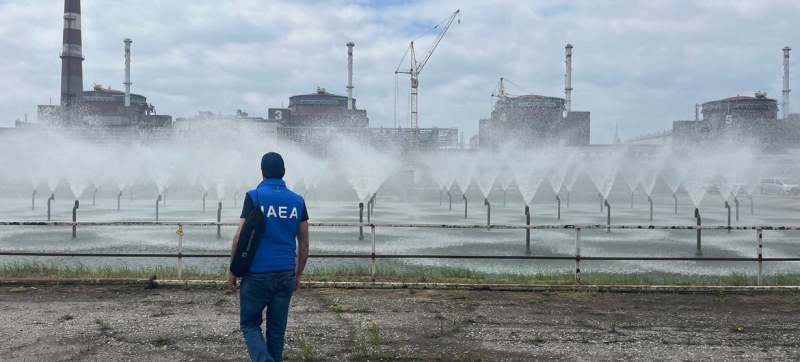
IAEA chief during visit to Zaporizhzhya NPP. Photo from archive IAEA chief to visit Zaporizhzhya NPP next week Peace and security
IAEA Director General Rafael Mariano Grossi will travel to Ukraine next week for high-level talks and to assess the situation at the Zaporizhzhya Nuclear Power Plant (ZNPP), which he says remains unstable.
This will be Grossi’s 10th visit to Ukraine, and the fifth time the IAEA chief has crossed the front line since a permanent IAEA presence was established at ZNPP two years ago.
“The IAEA acts quickly and decisively whenever and wherever threats to nuclear safety arise. Our active presence is essential to stabilise the situation. My message has been loud and clear throughout this tragic war: a nuclear accident must be avoided at all costs and a nuclear power plant must never be attacked,” Grossi said.
“The consequences could be catastrophic and no one would benefit. I remain determined to do everything possible to protect nuclear safety as long as the fighting continues,” he added.
Earlier this week, Grossi visited the Kursk Nuclear Power Plant in Russia. Following the visit, he described the situation there as “serious.”
At the Zaporizhzhya NPP, the IAEA team of experts reports that they continue to hear explosions, and military activity is observed near the plant. Due to reports of threats from drones, the team was ordered to take shelter indoors on August 20, and the experts had to postpone their planned tour until August 26.
Since Grossi last visited the ZNPP site in February this year, it has been hit by drone strikes, a power line has been damaged and, earlier this month, a fire caused significant damage to one of the two cooling towers.
Read also:
IAEA: Nuclear safety situation at ZNPP worsening
“Two years after I launched our mission at Europe’s largest nuclear power plant, it is needed more than ever. As recent, very worrying incidents make clear, the nuclear safety and security situation at the Zaporizhia Nuclear Power Plant remains extremely challenging,” Grossi said.
“Our teams there and elsewhere in Ukraine are doing indispensable work on behalf of the entire international community in very difficult circumstances,” the IAEA chief added.
Last week, the IAEA team at Zaporizhzhya NPP continued to conduct regular tours of the site. The experts visited, in particular, the turbine halls of reactor units 5 and 6, but were again not allowed to enter the western parts of the buildings, as was the case when they visited the turbine halls of units 3 and 4 in mid-August and unit 2 earlier this month.
Large-scale attacks on Ukraine’s energy infrastructure, Grossi noted, leading to interruptions in the power supply, pose an ongoing threat to nuclear safety at other nuclear power plants in the country.
Such attacks earlier this week led to the temporary shutdown or disconnection of some reactor units at the Rivne and South Ukraine NPPs. The external power supply situation at the Khmelnytsky NPP and the Chernobyl NPP was also affected. While none of these facilities have experienced a complete loss of off-site power, the safety of operating nuclear power plants relies heavily on a stable and reliable connection to the grid.
“While none of the plants have completely lost their access to the national power grid – something that has happened at Zaporizhzhya NPP on multiple occasions over the past two years – I am increasingly concerned about the growing vulnerability of Ukraine’s energy infrastructure and the potential impact this has on the safety of all operating nuclear power plants in Ukraine,” Grossi said.
